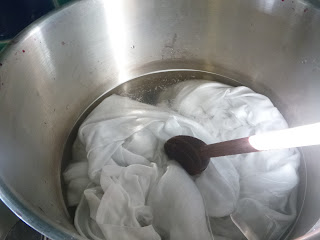I added baking soda to try and change the colour and it frothed all over the place and then turned gold coloured.
I also tried borage and cornflowers but got no colour at all ( at least no nice colour) and borage roots, brown.
I then tried oak bark because the oak tree up the back is too healthy and has no galls on it at all. The bark made a nice dark brown dye.
It didn't get much darker though.
and some more coreopsis because I thought it didn't make brown, but it made a very brownish orange.
and lastly I made some dye out of elderberries. It was green (because I added too much baking soda) but the wool didn't pick up much colour and ended up pale brownish green.







































